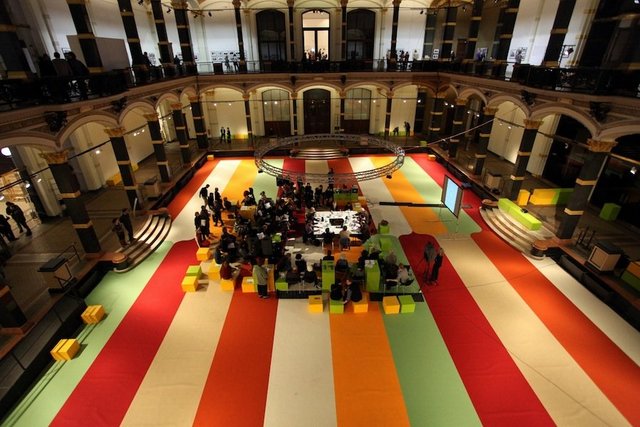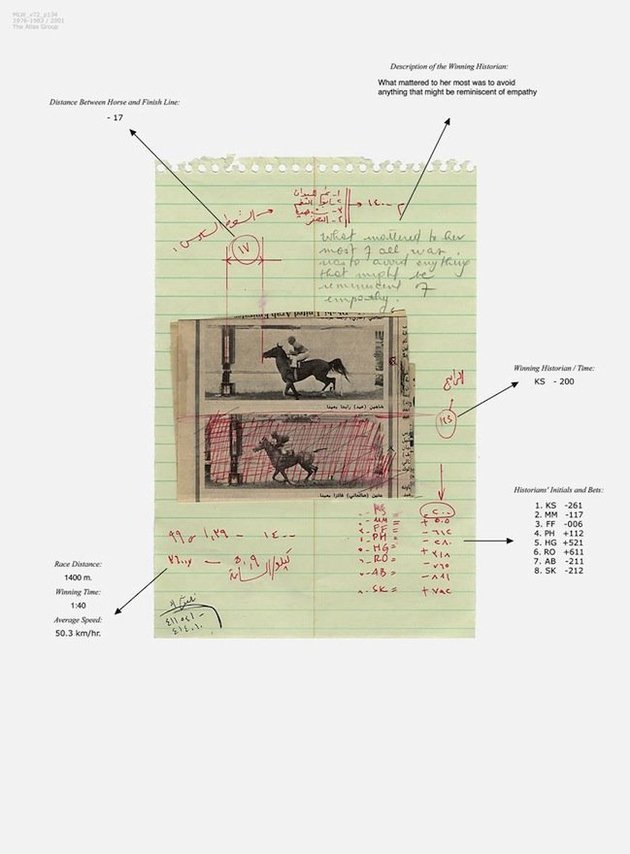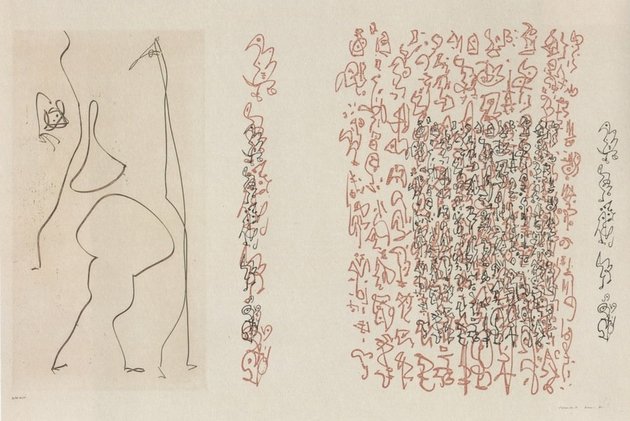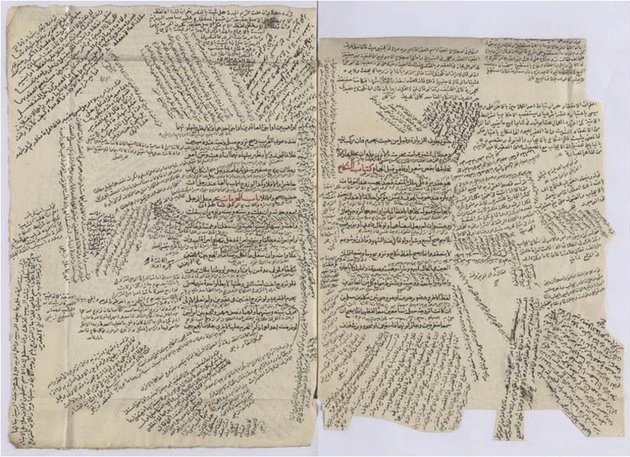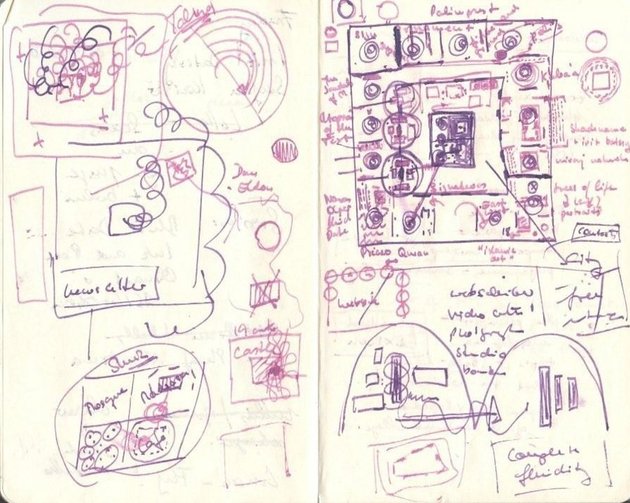Essays
TASWIR Projects
What is TASWIR Projects?
TASWIR[1] Projects is a nomadic platform for artistic and creative thinking that grew out of the TASWIR exhibition 2009-2010 at the Martin-Gropius-Bau in Berlin.[2] In this exhibition, over 50 artists, thinkers, curators, and other intellectual agents from different parts of the globe participated in an experiment of free association and poetic documentation, taking iconic artefacts, images, objects, manuscripts, and other items of classical Ottoman, Persian, Arabic, and Indian provenance out of context. Diverse matters generally related to Islamic art and culture were raised. The exhibition drew upon concepts like white ink, in-betweens, miraculous beginnings, indeterminacies, a-linear timelines, forthcoming pasts, fractal epistemic architectures, and so on. The TASWIR exhibition explored those concepts by way of artistic and other research in the form of an 'exhibition within an exhibition' inside the museum's inner atrium. In there, we, the TASWIR team, created a forum for public discourse, modelled after the medieval (Judeo-Arabic) house of learning, in which new knowledge is produced by way of repetition: the renewal takes place within the archive of tradition, new questions nestle in the cloudy zones of a relativity not yet defined, in-between objects and positions, meandering in diachronic loops of associative references back and forth, in and out of the linear references installed by European historiographies. We envisioned a place inside the museum in which production and (re)presentation become indistinguishable, meeting therein the limits of the museum's administration, who explained to us that such a thing is, indeed, impossible to achieve within any museum. Besides, we were up against the limits of time, three months in the autumn of 2009 proving to be much too short a length of time in which to explore the encyclopedic, if idiosyncratic, dimensions of 18 rooms of TASWIR in which 18 associative constellations of poetic documentation were submitted to public scrutiny.[3]
Upon the closure of the exhibition in January 2010, we decided that extensive future research on the constellations of TASWIR was necessary in order to fully endorse TASWIR's agenda. I realized that the thematic constellations of TASWIR, nine in total, indeed provide an encyclopedic matrix for an epistemic, yet individual, order of things beyond and besides disciplines and territorial belongings: 'white ink', 'point and line', 'miniature', 'polyphony', 'polis', 'east/west', 'Utopia/dystopia', 'eros', 'taswir'. TASWIR projects is convinced that the indeterminate order of knowledge emerging from a deeper engagement with this specific topography will undo some of the intellectual bifurcations that regularly inhabit all zones of conflict; we unreasonably claim that the contemporaneity of this agenda is still forthcoming, and are therefore presently busy transforming the exhibition rooms into thematic clusters presented in a nucleus at www.taswir.org/topography. [4]
The transformation of the TASWIR exhibition into an epistemic architecture is an ongoing process that I provisionally call the TASWIR 'institute', which is an imaginary institution. It does not possess an address, classes, secretaries, or furniture, but it does provide a TASWIR-specific agenda of research, topography, faculty, calendar, an atlas of object relations, and a team of collaborators. The institute – also called TASWIR projects – publishes TASWIR-related research, discusses exhibition concepts with curators, accompanies thinkers in writing or translating texts, assists students and volunteers in their various projects, and disseminates its methods at host institutions such as academies and universities across the globe. It works with a loosely-associated faculty of thinkers, artists, curators, filmmakers, poets, and political activists, in whose work we recognize fractal splinters of TASWIR's agenda. TASWIR builds an atlas of objects, artefacts, and positions that allows for an establishment of ever-recurrent, varying relationships in a digital setting yet to be expanded. And TASWIR projects offers the methods of the TASWIR atlas and its specific algorithm of indeterminate relativity to other institutions, museums, libraries, and clients interested in adopting the matrix of its epistemic structure. Yet TASWIR projects dreams and dreads its future, due to its excessive marginality brought about by playing across the radius of all territorial belongings, and by its radical belatedness within the current social media revolution.
How TASWIR Projects is Missing Contemporary Art: Plea for a Radical Belatedness
When I first got a chance to briefly speak about matters of TASWIR and of its atlas with the artist and thinker Walid Raad at a Beirut theatre, the very first thing he told me was: 'You are arriving late'. 'Maybe,' I said, 'I always thought I am arriving early!' We both laughed. Since then I knew: when people engage in questions of contemporaneity in art and theory, when artists and thinkers share the power of their poetic and political imagination through social media, even when we exchange our visions of freedom and justice supporting political and artistic activism in real time revolutions, we must not confuse the speed, immediacy, spontaneity, and contagiousness of social networking with the kind of untimely contemporaneity that the thinker and artist Jalal Toufic says is 'still forthcoming'.[5]
Lateral Shifts of Knowledge / Moving out of Academia
Of course, in one way, Raad was right. The TASWIR project, an imaginary institute that follows the idiosyncratic agenda of its own topography, that builds upon a stubborn renaissance of cosmopolitan traditions, ancient and modern, and that features the work of a loosely-associated faculty of artists and thinkers, with no reference to established disciplines or other territorial boundaries, neither institutional nor geo-political, of course arrives late onto a vibrant international scene in which thinkers, artists, and curators have long explored the nature of the contemporary, of non-western modernities, of a future past the former west.
We are in the midst of an ever more feverish activity archiving the fragmentation of knowledge; we are surrounded by international platforms for artistic research advancing paradigm shifts for philosophical, political, and aesthetic questions across disciplines, suggesting new ways in which knowledge is produced, splintered, archived, and displayed. It seems clear that future research in the arts and sciences is no longer put forward and negotiated mainly within universities and academies, and that new constellations and new research is being conducted in many different and dispersed ways, in and out of formal institutions of learning, in and out of the imaginary margins provided by creative individuals, in and out of places like biennales, international curators' meetings, art festivals, exhibitions, and other anarchic and offsite places, in which performance cultures meet post-disciplinary, object-related theoretical modes of discourse. Universities, with very few exceptions, have few opportunities to keep track; their departments make efforts to account for the ongoing emigration of groundbreaking research to discursive spaces of international (art) platforms, by founding interdisciplinary excellence clusters in which artists and freelancers play an increasing role. With the rare exception of academic frameworks, in which art and knowledge systems get themselves institutionally intertwined, the new framings of interdisciplinary academic projects of artistic research, however, usually miss real-time participation in current shifts of knowledge. Such participation would demand a subjective, individualized, idiosyncratic curriculum management on the part of the students, a requirement entirely contrary to the Bologna process[6] that prescribes and narrows scholarly programmes, especially in European universities today.
Window(less) Monads
It is obvious that social media and online communication, exchanging, updating, posting, (re-)producing, and disseminating knowledge in real-time conversations, not only provide current venues for knowledge exchange, but rather become themselves subject to artistic and theoretical investigation: digital infrastructures, their epistemic architectures, modes of temporality, velocities, the infinities inscribed in their space, their materiality, ways of archiving, undoing and overwriting identities, tracing individual and collective memories, their (in)determinacy in modes of (re)presentation, oscillating (hi)stories, and so on. How does the texture of this emerging 'flat surface' multi-verse, deep-time palimpsest, made of a zillion layers, facets of reflection, each an idiosyncratic centre of the universe, become hospitable to sharing knowledge? How do these universes-in-universes, windows' monads, whose modes of representation and image-making (TASWIR) are all undoing the Copernican revolution together with claiming 'the world is flat', actually speak to and communicate with one another? How does the specific kind of contemporaniety created by such epistemic revolution, in and out of three-dimensional space, in and out of the poetic imagination of the users, in and out of the bloodshed in human history – how does this poetry of the flat-world-revolution create, share, present, archive, and project its agenda in public? How does this question change the artistic, poetic, scholarly, philosophical, mathematical, political imagination?
Poetry of the Revolution – Plea for a Radical Belatedness, for Anarchy, and Idiosyncrasy
These questions are destined to lure curators and other agents among the new epistemic architects into a megalomaniac effort and exhaustion: proving an astonishing (angelic, medieval) quality of ubiquitous presence driven by a dizzying speed, curators and other creative epistemic agents increasingly play a dominant role in the current resetting of how knowledge is produced. In all seriousness, we find among the proclaimed tasks of the curator a call for 'global meta-curating', for reimagining entire cultural histories, reinventing the museums, re-linking the arts and sciences, rethinking spectatorship, providing 'intergenerational perspectives on recent developments across Africa, the Americas, Asia, Europe, and the Middle East', wanting to grasp the 'inner logic of contemporary art processes.'[7] Exuberant with the contagious jouissance of arriving just 'in time', of keeping up to speed in order to get to see (and to define) what is contemporary in the arts, these panoramic undertakings seem oddly imperial in scope - ironically so, as most of its agents are indebted to much post-colonial reflection and a huge network of genuine relations to literally all corners of the world.
Beginning at the Beginning, Again
I myself am quite intimidated by the speed of this market for curators and epistemic architects. In order to speak about the painful belatedness of the TASWIR project, its untimely idiosyncrasies driven by a quite personal facet of what Jalal Toufic names 'the withdrawal of tradition past a surpassing disaster',[8] and about its rather anarchic foundations – what were called 'non-foundations' by medieval Jewish and Arabic thinkers when discussing matters of creation and 'miraculous beginnings' – it will prove helpful to begin at the beginning again; possibly with the conversation at the Beirut theatre with Walid Raad about untimely arrivals/beginnings. It is impossible to know what triggered that laugh at the end of our conversation, but one possibility, so I thought afterwards, was that we might have laughed about the work Missing Lebanese Wars (1989).
Missing Contemporary Art
What we see here are the notebooks of Dr.Fadl Fakhouri, leading historian of the Lebanese Wars, and a member of the Atlas Group who spent his time collecting clippings from the Lebanese newspaper Annahar during the war, showing racehorses near the finishing line, with handwritten notes and calculations on each race. According to Walid Raad, the notebooks record a strange practice among Lebanese historians during the Lebanese Wars: Fakhouri and his colleagues were avid gamblers, who spent every Sunday at the race-track, submitting their bets.[9] However, their bet was not on the winning horse, but rather on 'how many fractions of a second the photographer would expose the frame before or after the horse crossed the finish line'. Curiously, the photographers never caught the horse online. It seems that photography, documentation, archiving, TASWIR, is all about the inbuilt differential that separates communication online from being contemporary: the contemporary is still forthcoming, or else is falling short. TASWIR – representation/image making – thus faces the paradoxical task of documenting the story of that differential, a story of resistance to going online.
The TASWIR Project / working off-line / Razan's Exhibition
From here on there are many ways to demonstrate how the TASWIR Project is missing contemporary art. I might as well begin with an example from my immediate environment: a young colleague, studying for a trilingual Master's programme in cultural intermediation and management with stations in Brussels, Venice, Barcelona, and Montpellier, a curator from Beirut/Damascus, who graciously elected TASWIR Projects for her internship, and who is now working in our tiny premises in a Berlin Altbau on a promising forthcoming exhibition – let's call it 'Razan's Exhibition'.[10] What she envisions is to expose the poetic imagination of people dying for freedom in the streets of Syria, exposing the excruciating state of belatedness and hope in which the agents of the revolution spend their nights writing banners and drawing caricatures and their days filming violence and injustice, using every venue of open-source, social media, and online communication in order to disseminate, preempt, and advance the power of the revolution, turning history upside down, reversing and resurrecting traditions that are in the process of withdrawal.
In order to imagine a redeeming future, however – and this is where the problems of TASWIR begin – one must also think of a bottomless past, written in white ink on white parchment, a past of the future onto which one inscribes ever-recurrent acts of intervention. In order to know that these interventions, our interventions, disruptive revolutionary moments, spreading into a zillion directions that are indeed miraculously free from the progressive timelines prescribed by European historiographies (whose call of 'not-yet!' to the colonized still echoes in the former west), a detour is necessary: a detour that takes time, a detour offline, a detour via nothingness, a crazy detour via the extensive archives of non-linear, atomist, anarchic, amazingly associative, forgotten, withdrawn, pre-colonial traditions of splintered, fractal thinking, mainly in the so-called middle ages, the early days of Kalam, the days of rabbinic midrash, masters of Hadith, Persian poetry, Islamic mystics, Sufis, and Kabbalists. This is the detour that the TASWIR project envisions developing and exposing. To anticipate these traditions yet again – together with Freud's psychic archive, Walter Benjamin's Arcades Project, Hélène Cixous' White Ink, Judith Butler's Antigone's Claim, Walid Raad's Artists' Index, Aby Warburg's Mnemosyne Atlas, and so on, means to touch upon the agenda of TASWIR projects, still forthcoming, in constellations that make up the topography of the TASWIR project.[11]
Detour via some Rabbinic Thinking/ Ways apart from the Curator's market
In order to work out the agenda of TASWIR, we need to learn how to thread the strings of our questions through the depth of time, proving the simultaneity of diachronic references, showing the contemporaneity that is forthcoming in the vicinity (not only) of the TASWIR project. The detours of TASWIR take us through venues far from the curator's market. Here I submit to the reader just one venue to imagine, one venue to begin with, one venue among many, taken from the cloudy field of 'white ink', which is one of the nine topoi of the topography of TASWIR.
In 2002, the Talmudic scholar Daniel Boyarin published an essay entitled Splintering the Logos. Indeterminacies of Meaning in Midrashic Texts.[12] In this essay, Boyarin focuses upon the resistance of rabbinic scholars in the 4th and 5th centuries. The rabbis escape the patristic and Hellenistic strategies of defining logos in dogmatic or syllological equations, demonstrating a process of splintering thinking instead, a kind of 'Schlitterlogik' – a logic of 'slipping' or 'slithering' – in the words of the art historian Aby Warburg.[13] In the case of the rabbis in their midrashic imagination (we may say the same for Freud's psychic archive, for Warburg's atlas), thinking does not proceed from proposition to proposition, but rather originates in the abysmal indeterminacies of a text that refuses determination and thus injects its readings from the perspective of a radical belatedness, from future to past, margin to centre, answer to question. Boyarin's plea for splintering the logos advances a critique of identity politics, collective bifurcations, fixations on gender, territorial belongings, apartheid and separation walls, and thus comes to turn the exilic, ubiquitous nature of rabbinic tradition against the status of its obvious withdrawal. It is the nature of this splintering process that seems irretrievably lost as a gesture of rabbinic thinking and excruciatingly difficult to retrieve after Jews in their majority settled their bodies and minds on territory rather than dispersion. It is this splintered thinking that has intrigued me in my own work over the last ten years, culminating in the TASWIR project, which is indebted to the archaic structures of pre-colonial Jewish and Muslim, rabbinic, Arabic, and other atomist readings of classical texts, Freudian dream-work, the Arcades Project of Walter Benjamin, the Mnemosyne Atlas of Aby Warburg, the work of the Surrealists, Dadaists, and so on.[14]
The TASWIR ATLAS
The more at random the elements which come together, the more likely the sparks of poetry will ignite and bring about a reinterpretation of things.
Max Ernst[15]
In order to demonstrate the power of poetic association governing the anti-chronology of TASWIR, let us look at a body of texts that we usually do not associate with a hypertext of multi-temporal dimensions, and which does not usually arouse in us any surrealist imagination, nor does it seem to resemble a psychic archive: let us look at a 9th century Hadith manuscript, one that deals with forbidden sexual relations and marriage laws.
It is not the content of the page that is of interest to me here. I rather invite the reader to look at the simultaneity of diachronic references in the margins of the text, a blog-like margin created by a process of interpretation that originates in recurrent, a-linear readings, sneaking into the blank spots in-between letters and words, resulting in a movement from margin to centre, creating a translucent palimpsest, multi-temporal vocal layers from various places on display on a single page.[16]
Thirteenth-century Jewish and Islamic mystical traditions developed an exuberant materialism in reading such multi-layered texts. In the works of Kabbalists and Sufi masters in southern France and Spain, divine infinity is configured as a semiotic body of imploding fullness, whose black holes/white ink paradoxically provide indeterminate grounds for creating worlds and 'miraculous beginnings'.[17]
From the standpoint of medieval Sufis and Kabbalists, the innumerable transmutations of meaning stem from the fact that each sign/letter is a component of the veil that renders the invisible visible and the visible invisible …
… Arabic letters – bones, tissue, and sinews of the Qur'anic body – are signs that point to the unseen and thereby reveal the light by concealing it. […] In a similar vein, the letters of the matrix text, Torah for Kabbalist, Qur'an for Sufi, reveal and conceal the divine essence, the face beyond all veils, the pre/face, devoid of form, the pre/text, devoid of letter.
Elliot R. Wolfson[18]
Hebrew and Arabic letters, according to thirteenth century mystical traditions, were thought of as images or bodies veiling the light of creation that they conceal. 'Black fire upon white fire',[19] Umm al-kitab, the 'mother of the book', veils the secrets of her body paradoxically by blankness, 'white ink' and 'miraculous beginnings' in which all readings (future/past) originate in an ever-recurrent forthcoming contemporaneity.
When letters and words seem liberated from the restraints of linear reasoning, whether in social media, real-time communication, or elsewhere, we are retrieving an ancient technique of toying, sampling, and re-mixing letters and things. This kind of anarchic strategy of reading provokes an untimely simultaneity of contexts, past and future, in which a word – or even just a letter or sign – accumulates its signifying capital, its extra-grammatical freedom in the eternal now of creative intervention. Google evokes an ancient pattern.[20]
When Time Itself Becomes Spatial
TASWIR's interest lies in resurrecting certain atomist (rabbinic, mutazilite, other) cosmopolitan strategies of reading and their implied non-linear temporalities, demonstrating their methodological congeniality with certain theories of indeterminacy and associative relativity, ancient and modern, trying to translate them into a spatial synopsis (atlas/exhibition), in which time itself becomes spatial.[21] TASWIR's first project was the Berlin exhibition 2009-2010, in which we took the interpretive gesture of 'miraculous beginnings', this act of taking root in the nothing in-between seriously as a curatorial method, turning the form of a margin commentary quite physically inside out: the taswir-'text', an associative narration of 18 rooms, was laid out and fixed onto the architectural circumference of the Martin-Gropius-Bau in Berlin, and the 'margin' transfigured into a space of public learning inside the museum's court, a place of artistic commentary and production.
The TASWIR project works precariously at the brink of (dis)appearance, as its unexpected associations can be unsettling, its moments of untimely arrival disorientating, and its contemporaneity difficult to grasp. The Project over long periods lives by what Anton Vidokle terms 'time/bank' principles, sharing resources, skills, time, and artistic and scholarly proficiencies. We dream of a future augmenting the narrow spot of TASWIR's present idios cosmos, one that settles into the inner archive of a cosmopolitan tradition yet to be retrieved.
[1] Taswir translates as representation/image making in Arabic, Persian, Ottoman Turkish, Hindu and Urdu.
[2] Conceived of by A.S. Bruckstein Çoruh in cooperation with the Berliner Festspiele and ha'atelier (www.ha-atelier.de), supported by the Robert Bosch Foundation.
[3] Among the participating artists and thinkers were: Jumana Emil Abboud, Arwa Abouon, Etel Adnan, Maliheh Afnan, Abdul-Rahim Al-Shaikh, Buthayna Ali, Khaled Amine, Chant Avedissian, Samer Barkoui, Taysir Batniji, Joshua Borkovsky, Gabriele Brandstetter, Sidney Corbett, Graham Day, Song Dong, Sherif El-Azma, Shahram Entekhabi, Orhan Esen, Parastou Forouhar, William Forsythe, Ilse und Pierre Garnier, Abdulnasser Gharem, Sakir Gökçebağ, Erik Göngrich, Maria Golia, the late Oleg Grabar, Dirk Hartwig, Mona Hatoum, Susan Hefuna, Rebecca Horn, Rami Abdul Jabbar, Ali Kaaf, Hayv Kahraman, Ik-Joong Kang, Hüseyin Karagöz, Navid Kermani, Idris Khan, Yayoi Kusama, Wolfgang Laib, Beral Madra, Sarat Maharaj, Nja Mahdaoui, Nalini Malani, Yang Maoyuan, Marwan, Murat Morova, Rabih Mroué, Moataz Nasr, Timo Nasseri, Melanie Nazmy-Ghandchi, Shady El Noshokaty, Alexander Polzin, Walid Raad, Amnon Raz-Krakotzkin, Seifollah Samadian, Joachim Sartorius, Oliver Schneller, Maria Magdalena Schwaegermann, SEMA, Joseph Semah, Avinoam Shalem, Raqib Shaw, Shahzia Sikander, Walid Siti, Bettina Springer, Staatskapelle Berlin, Anneh Mohammad Tatari, Hale Tenger, Sadegh Tirafkan, Sencer Vardarman, Charles Hossein Zenderoudi, and Sobhi al-Zobaidi. Among the participating collections, galleries, and international museums were Staatliche Museen zu Berlin, the British Library, the British Museum, the Victoria and Albert Museum, Bibliothèque Nationale de France, Centre Pompidou, Museu Calouste Gulbenkian, the State Hermitage Museum, Kunsthistorisches Museum Wien, Buchmann Galerie, Alexander Ochs Galleries, Rose Issa Projects, Galerie Lelong, and The Forsythe Company.
[4] I especially thank Hendrik V. Beust for his brilliance in building up an online-presence for TASWIR, and Lotte Fasshauer for providing continuous support.
[5] Jalal Toufic, 'The Contemporary is Still Forthcoming,' e-flux Journal 28 (2011): http://www.e-flux.com/journal/the-contemporary-is-still-forthcoming/.
[6] A series of ministerial meetings and agreements between European countries designed to ensure comparability in the standards and quality of higher education qualifications, see: http://www.ond.vlaanderen.be/hogeronderwijs/bologna/about/
[7] Citations from various back cover texts on the task of contemporary curating, especially commentaries on Terry Smith's Thinking Contemporary Curating, published by Independent Curators International in 2012.
[8] The concepts developed by the thinker, artist, and filmmaker Jalal Toufic in The Withdrawal of Tradition Past a Surpassing Disaster (2009) and other works cannot be overestimated when thinking about the contemporary in the arts and sciences. See also: Jalal Toufic, Forthcoming (Berkeley: Atelos, 2001) and other works, graciously published under www.jalaltoufic.com
[10] Obviously, ’Razan’s Exhibition,’ as well as some other imaginary projects of TASWIR, would make interesting proposals for analogue venues.
[11] The topography of the TASWIR institute in all its deceptive brevity hides the 'idio cosmos' of the TASWIR project, an encyclopedic nucleus, induced from artefacts, positions, events, and other matters in its vicinity http://www.taswir.org/topography/
[12] Daniel Boyarin, Den Logos zersplittern. Zur Genealogie der Nichtbestimmbarkeit des Textsinns im Midrasch, essay series ha'atelier Nr. 3, ed. Almút Sh. Bruckstein (Berlin: Philo, 2002); see also Daniel Boyarin, Border Lines: The Partition of Judaeo-Christianity (Philadelphia: University of Pennsylvania Press, 2004), 151-225.
[14] On the process of how pre-colonial Jewish and Arab traditions were both exiled from the cultural canon of European memory, see: Gil Anidjar, The Jew, the Arab: A History of the Enemy (Stanford: Stanford University Press, 2003).
[16] 'Contemporaneity consists precisely in the acceleration, ubiquity, and constancy of radical disjuncture of perception, […] in the actual coincidence of asynchronous temporalities, […] all thrown together in ways that highlight the fast-growing inequalities within and between them'. Terry Smith et al., eds., Antinomies of Art and Culture: Modernity, Postmodernity, Contemporaneity (Durham: Duke University Press, 2008), 8-9.
[17] This term is coined by Walid Raad, see: Toufic, The Withdrawal of Tradition Past a Surpassing Disaster, op. cit., 40.
[18] Elliot R. Wolfson, Language, Eros, Being. Kabbalistic Hermeneutics and Poetic Imagination (New York: Fordham University Press, 2004), 205-206. Wolfson engages Ibn Arabi and other classical Arabic sources to advance a parallel universe of Jewish and Sufi mysticism.
[19] See: Gershom Sholem, 'The Significance of Thora in Jewish Mysticism,' On the Kabbalah and its Symbolism (New York: Schocken, 1996), 37-44; and many others.
[20] Boris Groys, Google: Words beyond Grammar/Google: Worte jenseits der Grammatik, 100 Notes - 100 Thoughts (Ostfildern: Hatje Canz, 2012). The connection to Midrash and Hadith and theories of messianic time is mine.
[21] Such a scene of pictorial writing, with its associative chains and nods of fluidity, does 'no longer obey … the laws of linear temporalities'. See: Jacques Derrida, 'Freud and the Scene of Writing' in Writing and Difference, trans. Alan Bass (London: Routledge, 2001), 272-273.
[22] From the diary of the composer Oliver Schneller, An Atlas of Sounds (2009), commissioned work for the TASWIR exhibition.

